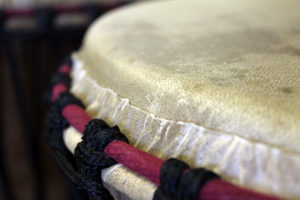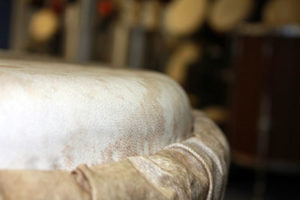1. A well rounded bearing edge. The bearing edge is the top edge of the drum that makes direct contact with the head. The way this edge is made will have a profound effect on the sound of your drum. Anything less than a curved, routered half inch size edge can hurt your hands after a short time playing.
Most drums from Guinea, Mali and Ivory Coast have thick enough shells that will allow up to a one inch curved edge, which is ideal. Drums directly imported from Africa often have the edges flat so the drum loses a lot of sound. The best African drum makers will curve their edges nicely. If you have a drum with a flat bearing edge? Having the bearing edge routered into a nice curve professionally will improve your drum’s sound considerably. Ghana drums are often too thin at the top for a one inch bearing edge, but are thick enough for a half inch one, which still gives reasonable comfort. Avoid narrow bearing edges (less than 1/2″), even if the drum sounds good. Your hands will be in pain in only a few minutes.
The best bearing edges I have seen are on djembes from Drum Skulls, Guinea, and the Groove Masters Percussion – Ivory Coast djembes. For Manufactured djembes, the best edges are Groove Masters Percussion, Toca and Meinl. All three of these brands are made by the same manufacturer in Indonesia and come with consistent machine-cut edges. Composite and fibreglass djembes by Groovemasters Percussion, Toca, and Meinl all have identical, consistent and comfortable bearing edges. The high end wood djembes by these three brands have an approximately ¾” bearing edge. Remo brand entry-level djembes have sharp edges and quickly become painful to play. Remo’s more expensive djembes have improved in recent years.
non rounded edge Well rounded edge
2. Sound versus weight. For wood djembes, it widely accepted that hardwood djembes provide better sound and projection. Sound quality is subjective and I have heard some great softwood Ghana drums. The hardwood does give more of the gymnasium effect and thus more projection. I personally like the Ghana drums for ensembles and the Ivory Coast djembes as a lead djembe. Good Indonesian wood djembes like the 3 brands mentioned are made of mahogany but seem to have a little less projection than African hardwood drums but a good sound for blending. The only light wood is the Ghana drum and that has made the Twiniboa Ghana drum very popular for seniors, women and schools or anyone where weight may be an issue. For manufactured non wood djembes the fiberglass seems to project more than the Toca Freestyle plastic drums. I would be interested in seeing some kind of research on this. Fibreglass due to being more expensive to manufacture and in my opinion a better drum tends be more expensive to purchase however. All three brands are quite light and very versatile for most situations. I am in schools over 100 days a year doing workshops with groupings of up to 150 kids at a time. I like the fiberglass for kids for logistical purposes and an Ivory Coast Lead djembe.
3. Rope quality. Good rope quality is essential. This is an area some African drums often fall behind. The best rope has a core to prevent stretching and constant retuning. The manufacturer who makes virtually all of the better Indonesian drums in North America uses excellent rope. Having good rope and because he kiln dries all his shells probably makes his drums the most durable on the market. He also uses good rope in the Meinl and Groove Masters Percussion fibre djembes and Toca PVC djembes.
4. Head quality. African goat skins from Guinea, Mali and Ivory Coast tend to be thicker and stronger. Ghana skins are often thinner because they have the “pigmy” goat breed. This small goat is tough and gives a bigger and longer sustaining bass sound. Excellent for drums with 11” heads and smaller and widely used in larger drums also. North American goat is stretchy and in my opinion almost unusable. For all African skins be sure there is a veterinarians inspection certificate available. Drums and skins imported by container by Ghanian export law must be inspected for anthrax (anthrax cases are extremely rare however). If the skins are imported by air shipments the veterinarian certificate is not required. It is good to ask how the skins or drums arrived for this reason. Most Ivory Coast skins are shipped through Ghana so same laws apply. Pakistani skins tend to be thinner and may break easier and have no need for inspections because of how they are processed and the area the goats are raised. Best skins I have used are the ones from the Indonesian Pro series djembes. They are more expensive however. There are also cheaper Indonesian skins comparable to the Pakistani ones but you can tell the difference immediately by sound and they have a more manufactured look. Haired or non haired skins- I stopped using haired skins because of the North American pantry moth. They can turn a beautiful drum into a mess in a few weeks. I also like the hygienic aspect of hairless djembes.

